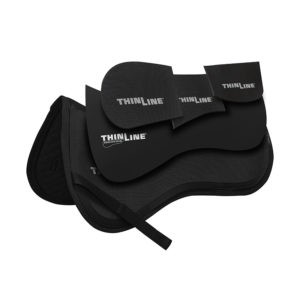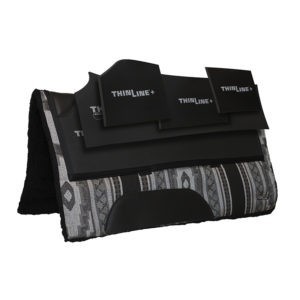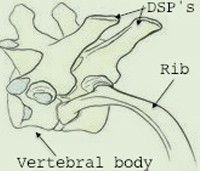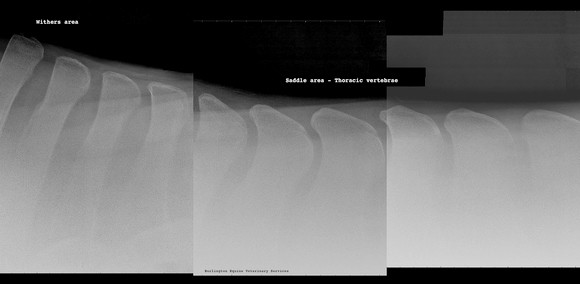Sometimes just a tack change can successfully head off major veterinary bills. Endorsed by Veterinarians for Kissing Spine.
ThinLine extends you a money-back guarantee your horses’ back pain will decrease in a ThinLine Saddle Pad.
ThinLine’s amazing, proven open-cell foam is available on every style of saddle pad.
Kissing Spine Plan Of Action
As you know, here at ThinLine, we are committed to making life better for horses. We know that your horse’s health is a top priority. After years of working with veterinarians, trainers, and horse owners we have consolidated information on Kissing Spine Disease in performance horses and put together a plan of action to help you combat this disease.
Often overlooked, under-treated, and misunderstood. Kissing Spine in horses is frequently associated with bad behavior.
My horse is behaving badly and I cannot figure out why. I am afraid the veterinarian will say it is kissing spine disease, and I do not want to think about kissing spine surgery. What can I do?
If you are beginning to suspect your horses’ unhappiness may be associated with back pain, we have set forth the easiest methods for you to check off your list before entertaining more aggressive treatments.
Alternative modalities such as acupuncture, chiropractic adjustments, mesotherapy, and/or massage can have a role here. Ask your veterinarian about shock wave therapy too! Use them as a first-line treatment as well as in a more supportive role. “In my opinion, if we have a case of significant bone reaction along with kissing spines then the benefits of chiropractic may be minimal and possibly counterproductive; however, acupuncture or mesotherapy can reduce the pain and dysfunction. There are a number of individuals in our area that practice equine massage and are frequently recommended”. (Frank Frantz, Burlington Equine).
Training and Physical Therapy
Again physical therapy should be considered the essential component for the management of this condition. The main concepts are using exercises that help build core strength and allow the back to lift. Lunge work often with side reins, using a Pessoa system, and belly lifts are all designed to help strengthen the back and pelvic muscles.
When we refer to building core strength it’s not the back muscles that are over the spine but rather the ones adjacent to the spine (multifidus muscles), the ones that go from under the spine to the hips (psoas muscles), and the ones that run along the abdominal wall (abdominal oblique muscles) that we try to strengthen. These are the muscles that work to lift or flex the back versus the ones on top that extend the back.
Of course, the physical therapy piece of the puzzle is easier than it sounds, and may take months to fully appreciate the benefits. “I find that combining it along with some type of therapy that makes the horse more comfortable is the best way to go.” (Frank Frantz, Burlington Equine).
Saddle Fit
Calling a certified Saddle fitter in your area should be one of the first things you do with any horse who is showing discomfort with tack. Always check your horse after a good ride and make sure they are not exhibiting pain. Gently press fingers on either side of the spine from wither to croup. Your horse should not react by lowering his back. Some horses are ticklish, so do try a baseline with this after a few days off. Simply google the saddle fitter nearest you. Saddle fitters are money well spent with all horses.
Equine Rehabilitation and Schooling
From Horse and Hound UK:
Equine surgeon, Bruce Bladon points out that a colleague in Sweden who has operated on a lot of kissing spine disease cases has more recently had excellent results — without surgery — with horses sent to a rider experienced in equine rehabilitation and re-schooling.
“This makes sense,” says Bruce. “We’re talking about the normal flexibility of the spine, occasionally resulting in the edges of the bones ‘kissing’. It’s easy to imagine how a different rider or saddle, or increased muscle tone as a result of physiotherapy and a change in work, might prevent this.
“It’s also easy to see how the results of schooling a horse could be so different, depending on the psychology of the rider,” adds Bruce, who believes that kissing spine surgery can, in some cases, have the effect of a placebo.
“The difference in attitude between a rider concerned that their horse is behaving like it is because it has an underlying disease, and a rider who knows that their horse has had surgery for this disease and is now ‘cured’, will be considerable — and quite rightly so.
“But it is major surgery and this has kept a ‘lid’ on the use of the procedure — no one wants to do it unless they really think it will be beneficial.”
Sometimes just a tack change can successfully head off major veterinary bills.
Whether the culprit is saddle fit, less-than-perfect training, or less-than-perfect riding we know for certain; that the comfort of the horse’s back needs to be addressed as quickly and as simply as possible. Both pre and post-surgical horses find relief in ThinLine’s therapeutic saddle pads and saddle fitting shims. For all our pads see our English saddle pad selection and Western saddle pad selection.
Saddle Pad Endorsed by Veterinarians for Horses with Kissing Spine
More Information about Kissing Spine Disease from a Top Veterinarian
By Randy Frantz of Burlington Equine Veterinary Medicine Services, LLC, Vermont
Dorsal Spinous Process (DSP) impingement or “Kissing Spines” is a condition recognized as a significant issue for horses. What constitutes the problem is debatable and how to make a conclusive diagnosis can be an elusive process. The following article will discuss the anatomic findings, diagnostic process, therapeutic options, and prognosis.
In order to understand the issues behind dorsal spinous processes (DSP) impingement, you have to understand a few anatomical factors. Generally, the problem is located in the thoracic section of the vertebral column – the area where the rider sits. Less commonly, the involvement of the lumbar vertebrae behind the saddle area can be the source of the problem. If you have young horses, consider getting radiographs not only to check for kissing spine, but as a reference point for the future as well.
The Vertebrae:
As you can see from the attached picture to the left, the thoracic vertebrae begin with the withers and go through the saddle area.
The part of the vertebrae that we are interested in is the vertical part that projects up and should be evenly spaced from the adjacent process. In the following picture, two dorsal spinous processes are seen with the correct relationship.
In order to understand the correct relationship between the vertebrae in the back, a radiograph (x-ray) is the easiest way to see how the bones sit relative to one another. The following picture is of a combined back radiograph from a horse with normal spacing. The left side of the image starts with the withers and moves down the back to the right showing the lower back. The tall vertical DSPs that make up the withers are narrow and long but are usually not involved with Kissing Spine Disease; instead, it’s usually the group of vertebrae behind this area – the thoracic vertebrae, in the area where the rider sits. As you can see the spacing between the DSPs is even and there is no significant bone reaction.
The next picture is of an abnormal radiograph which clearly depicts kissing spine disease. As you can see the finger-like spinous processes are either touching the adjacent process or in some cases actually overlapping.
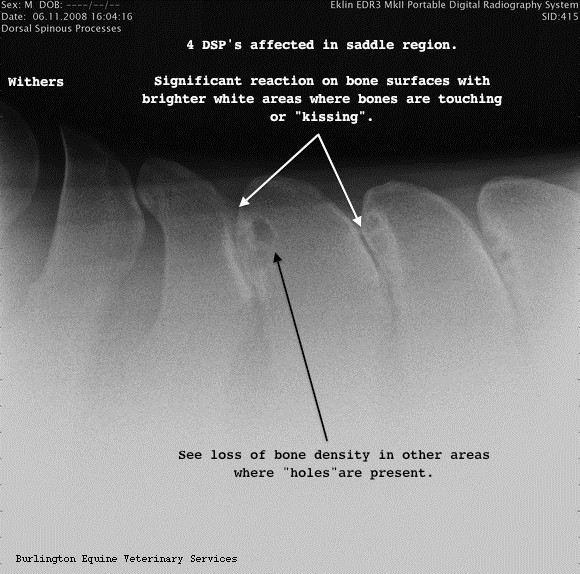
Clinical Signs of Kissing Spine Disease
Horses with this condition can exhibit a range of signs from being asymptomatic, that is exhibiting no abnormal signs, up to having a horse that is unrideable, possibly bucking, refusing to be saddled, and/or having behavioral issues even on the ground. The question isn’t understanding the more obviously affected horse; instead, it’s the asymptomatic horses. The radiographic changes didn’t occur overnight and there are certain horses that have been in regular work during this time and are able to jump and be used for dressage and/or western pleasure while the radiographs would have looked abnormal. Something must change in order for the problem to be evident and something must change again if the problem is going to get under control.
I have heard a variety of complaints from the riders and trainers over the years associated with this condition, the most common one relates to behavior-training issues. Generally, the horses may not be overtly lame, but rather exhibit avoidance behaviors that affect their work such as: refusing to accept bit contact. preferring to travel with their heads up and their backs dropped (not rounded), unwilling to bend one direction or the other, not consistently picking up the correct lead, horse’s movement feeling disconnected, or possibly cross cantering. Obviously, these signs could be associated with a number of issues for example stomach ulcers, Lyme disease, tack, training, and rider to name a few.
Diagnosis of Kissing Spine in Horses
Making the diagnosis can be a straightforward process in some cases; in others, it’s a process of elimination. The history and clinical signs are particularly beneficial to the Veterinarian. Following radiographs are the first line of defense. Digital X-rays allow us to take radiographs of a horse’s back in a matter of minutes and clearly see if there are issues present as seen in the image below.
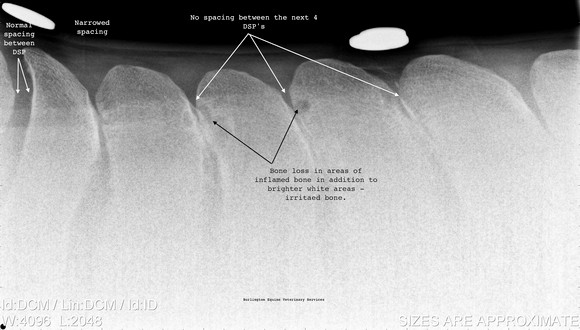
Horse with back pain, reluctant to collect and move forward
Ultrasound
Ultrasound technology is also sometimes employed. Traditionally it’s been considered a great modality to evaluate soft tissues, but it’s exceptionally helpful when looking at bone surfaces. While X-rays penetrate bone and show the margins and inside of bones, ultrasound shows a significant amount of detail about the bone surface and soft tissues attached to them. What can’t be appreciated in some circumstances without ultrasound is back soreness from the ligament that runs over the spine and inserts into these DSPs nor the ligaments that are located between the bones.
Thermography
In addition to other modalities and a complete physical examination of the individual horse, Thermography is also used in cases where I want to evaluate heat output which can correlate to inflammation. By using a thermal camera I can visualize areas of the back, legs, and even saddle fit. The more intensely red or white areas correlate with inflammation. The following two pictures demonstrate a more normal back on the left compared to the one on the right with more inflammation in the saddle (thoracic) area as well as over the hips (sacroiliac) areas.

Normal image with some red color indicating warmth in the saddle area

In cases where there are more questions as to the involvement of the back versus other areas, a bone scan can be done. These are procedures done at referral hospitals. The advantage is that, like thermography, they are dynamic exams and show problems in real-time as opposed to static exams such as radiographs or ultrasound that show what is currently there, but don’t necessarily correlate to inflammation.

Nuclear scan detects the output of accumulated radioactive material using a camera.
Treatment for Performance Horses Diagnosed with Kissing Spine Disease
As might be expected, treatments can vary. The most important concept is that regardless of the treatment, physical therapy is even more integral to a successful outcome. What I am referring to here is that the treatments can help manage the soreness short term and even for longer periods, but without instituting a modification in the riding, training, and/or tack the problem may continue to affect the horse.
Generally, I have found that treatment of the affected areas with injections using a combination of corticosteroids and Sarapin has been beneficial. In most cases that will be my first treatment and often done at the same time, the radiographs are taken if the diagnosis is definitive.
Over the years I have treated numerous horses with Shockwave Therapy (SWT) and have also found this effective; in fact, for some horses, the benefits are about the same as injections. SWT is also beneficial as a management tool, that is allowing treatment periodically and/or a short time before competition may decrease the discomfort associated with this chronic condition.
In some acute conditions, I have effectively used a laser to treat focal areas of inflammation. Laser treatments can treat inflammation of the bone, soft tissues, and nerves.
Tildren is the newest medication that I would add to my list. Most of the research on this drug has been done in Europe and it has proven benefits for horses with kissing spine disease. The essential mechanism is that it decreases the bone-destructive process of bone inflammation and “turns on” the bone cells that help to rebuild damaged bone. What is unique with this medication is that its role is not to mask pain, but to improve damaged bone which interrupts the destructive process and improves long-term horse comfort. Currently, I import it from France with a special permit and have used it successfully in numerous cases. While it is somewhat costly, the benefits far outweigh any negatives.
The horse below with kissing spines that were unwilling to go forward comfortably refused jumps and would not collect well was treated with Tildren. Following treatment, he was markedly improved and the results lasted longer than when just local injections were used.
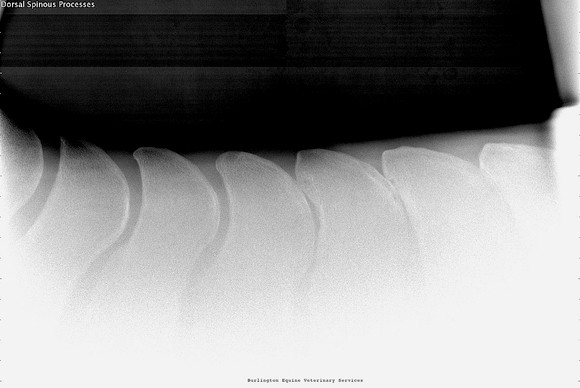
Alternative Modalities
Other methods, such as acupuncture, chiropractic adjustments, mesotherapy, and/or massage can also have a role here. I have used them as a first-line treatment as well as in a more supportive role. If we have a case of significant bone reaction along with kissing spines, the benefits of chiropractic may be minimal and possibly counterproductive; however, acupuncture or mesotherapy can reduce the pain and dysfunction. There are a number of individuals in our area who practice equine massage and are frequently recommended by me.
Again physical therapy should be considered the essential component for the management of this condition. The main concepts are using exercises that help build core strength and allow the back to lift. Lunge work often with side reins, using an Equiband or Pessoa system, and belly lifts are all designed to help strengthen the back and abdominal muscles.
When we refer to building core strength it’s not the back muscles that are over the spine but rather the ones adjacent to the spine (multifidus muscles), the ones that go from under the spine to the hips (psoas muscles), and the ones that run along the abdominal wall (abdominal oblique muscles) that we try to strengthen. These are the muscles that work to lift or flex the back versus the ones on top that extend the back.
Of course, the physical therapy piece of the puzzle is easier than it sounds, and may take months to fully appreciate the benefits. I find that combining it with some type of therapy that makes the horse more comfortable is the best way to go.
Saddle Pad Endorsed by Veterinarians for Horses with Kissing Spines
Using a ThinLine pad regardless of surgical treatment or not is beneficial for many horses and aids in building the horse’s muscles throughout the lumbar region. The shock-absorbing technology guarantees pain reduction, although it is not a substitute for accurate diagnosis.
Saddle Pad Endorsed by Veterinarians for Horses with Kissing Spine
ThinLine is a company dedicated to delivering protection, comfort, and performance for horses and their riders.
Surgical Treatment
Sometimes, even when following all the guidelines mentioned above, for severe cases, surgical intervention is necessary for affected horses.
The procedure that is routinely performed for the management of impinging DSPs is an interspinous ligament desmotomy (ISLD). Once the most active areas of impingement are identified (both radiographically and with nuclear scintigraphy), a small 1-2 cm incision is made at the site of impingement. The interspinous ligament between the two affected DSPs is cut, relieving the pressure and increasing the space between the DSPs. This process is repeated for all of the areas of impingement along the back. Once completed, additional radiographs are taken to ensure there is improved spacing between the DSPs. This procedure is carried out while the horse is standing, under standing sedation, not general anesthesia and it typically takes 30-45 minutes. Once the incision is healed, and back and core muscles are strengthened, over 85% of horses return to performance careers, and most importantly, the horse is comfortable.

